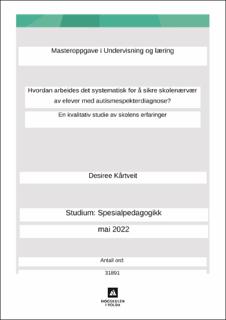| dc.contributor.advisor | Håberg, Liv Ingrid Aske | |
| dc.contributor.author | Kårtveit, Desiree | |
| dc.coverage.spatial | Norway | en_US |
| dc.date.accessioned | 2022-09-20T12:56:51Z | |
| dc.date.available | 2022-09-20T12:56:51Z | |
| dc.date.issued | 2022 | |
| dc.identifier.uri | https://hdl.handle.net/11250/3019196 | |
| dc.description.abstract | Abstract
This study is about school presence and pupils with autism spectre diagnosis. The background for the subject matter chosen in this study, is scientific research made by Ellen Kathrine Munkhaugen, School refusal behaviour in students with autism spectrum disorder. An exploratory study of frequency and associated factors (2019), where she concludes that pupils with autism spectre diagnosis are more prone to develop school refusal behaviour than other pupils. School refusal and absence from school has become an increasing problem in general and Trude Havik has done research on this phenomenon. Based on the conclusion that pupils with autism spectre diagnosis are more at risk for this phenomenon than others, it is common sense for me to think that the school must work to try to prevent this behaviour. The question is then:
How does the school work systematically to ensure they maintain the presence at school for pupils with autism spectre diagnosis?
The purpose of this study is to show how the school works to maintain the presence of the pupils with autism spectre diagnosis at school, and be an example of preventive work in a good learning environment.
The examination of this issue has been done qualitatively by way of semi structured focus group interviews with four participants from various positions at the same school. The study has had a phenomenological and hermeneutic scientific theoretical perspective, and the findings has come through social constructivist interaction.
Central findings in the study points to various areas of everyday life at school, that pupils with autism spectre diagnosis needs to get arranged and how the school performs this arrangement. The discussion shows that a wide range of competence is needed to facilitate for pupils with autism spectre diagnosis. At the same time, we must be aware of the school's risk factors that can trigger school refusal behaviour. Summarized we can say that if only one measure is to be taken to maintain presence in school for pupils with autism spectre diagnosis, it might be useful to structure everyday school life so it appears predictable and safe | en_US |
| dc.description.abstract | Sammendrag
Denne studien handler om skolenærvær og elever med autismespekterdiagnose. Bakgrunnen for valg av tematikken i denne studien er forskning utført av Ellen Kathrine Munkhaugen, School refusal behaviour in students with autism spectrum disorder. An exploratory study of frequency and associated factors (2019), hvor hun konkluderer med at elever med autismespekterdiagnose er mer utsatt for å utvikle skolevegringsatferd enn andre elever. Skolevegring og fravær i skolen er blitt et økende problem generelt og Trude Havik har forsket på dette fenomenet. Ut fra at elever med autismespekterdiagnoser er mer utsatte for dette fenomenet enn andre, er det naturlig for meg å tenke at da må skolen forebygge for denne atferden og problemstillingen er:
Hvordan arbeides det systematisk for å sikre skolenærvær av elever med autismespekterdiagnose?
Formålet med denne studien er å vise til hvordan en skole arbeider for å opprettholde tilstedeværelsen av elevene med autismespekterdiagnose og være et eksempel på forebyggende arbeid i et godt læringsmiljø.
Undersøkelsen av problemstillingen er gjennomført med et kvalitativt semistrukturert fokusgruppeintervju med fire deltakere med ulike stillinger fra den samme skolen. Studien har hatt et fenomenologisk og hermeneutisk vitenskapsteoretisk perspektiv og funn i studien er kommet frem gjennom sosialkonstruktivistisk samhandling.
Sentrale funn i studien viser til ulike områder i skolehverdagen, som elever med autismespekterdiagnose har behov for å få tilrettelagt og hvordan denne skolen utfører denne tilretteleggingen. Drøftingen viser at det trengs bred kompetanse for å kunne tilrettelegge for elever med autismespekterdiagnose, samtidig som man må være bevisst skolens risikofaktorer, som kan utløse skolevegringsatferd. Oppsummert kan man si at skal man utføre bare et tiltak for å opprettholde skolenærværet for elever med autismespekterdiagnose, så kan det være nyttig å strukturere skolehverdagen slik at den fremstår som forutsigbar og trygg | nb_NO |
| dc.language.iso | nob | |
| dc.publisher | Høgskulen i Volda | nn_NO |
| dc.title | Hvordan arbeides det systematisk for å sikre skoienærvær av elever med autismespekterdiagnose?. En kvalitativ studie av skolens erfaringer. | nb_ |
| dc.title.alternative | How does the school work systematically to ensure they maintain the presence at school for pupils with autism spectre diagnosis? | en_US |
| dc.title.alternative | Skolenærvær og elever med ASF | nb_NO |
| dc.type | Master thesis | en_US |
| dc.rights.holder | Forfattaren | nn_NO |
| dc.subject.nsi | VDP::Samfunnsvitenskap: 200::Pedagogiske fag: 280::Spesialpedagogikk: 282 | nb_NO |
| dc.source.pagenumber | 121 | en_US |
| dc.relation.project | NSD 466031 | |
| dc.description.localcode | UL-306 | |
